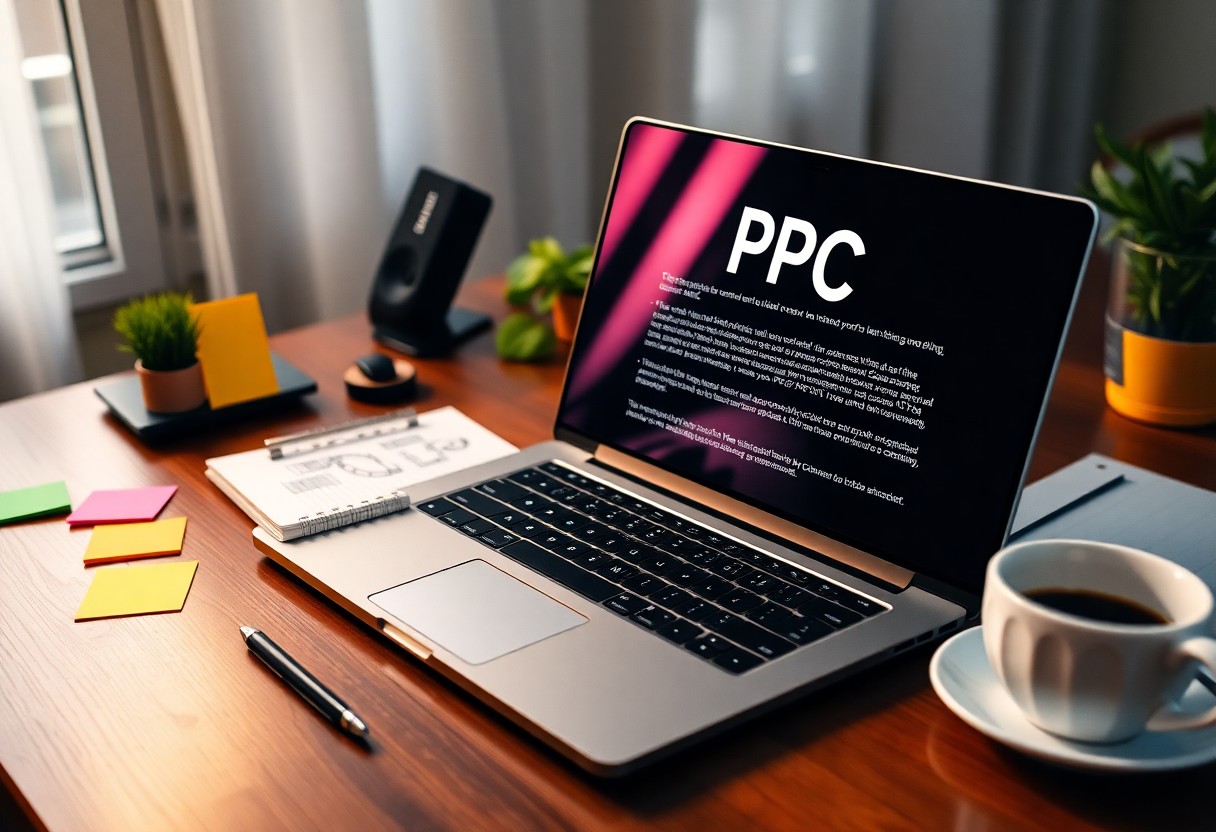Invaluable How-to Tips For Creating Compelling PPC Copy
Tips for writing effective PPC copy can transform your advertising strategy and maximize conversions. You need to combine attention-grabbing headlines with clear, persuasive messaging that aligns with your target audience’s needs. By focusing on strong calls to action and highlighting unique selling points, you can craft compelling ads that stand out. In this guide, you’ll discover vital techniques to enhance your PPC campaigns and drive meaningful results.
Understanding PPC Copy
To effectively engage potential customers and drive conversions through paid advertising, you must grasp the concept of PPC (Pay-Per-Click) copy. PPC copy encompasses the text elements of your online ads, which can include headlines, descriptions, and call-to-action phrases. These carefully crafted pieces of content aim to persuade users to click on your ad and ultimately take action, whether that’s visiting your website, signing up for a newsletter, or making a purchase. By honing your skills in writing compelling PPC copy, you will set yourself apart from competitors and maximize the return on your advertising investment.
What is PPC Copy?
For any successful PPC campaign, the copy is the main tool that communicates your offering directly to your audience. It is designed not only to inform but also to entice prospective customers by highlighting the benefits of your product or service. Each character counts, since space is often limited, and your copy should be sharply focused on creating a strong emotional appeal. By using persuasive language and addressing the needs and desires of your audience, you can craft PPC copy that resonates and compels action.
Importance of Compelling Copy in PPC
There’s no doubt that compelling PPC copy can significantly influence the success of your advertising efforts. When you invest time in creating persuasive and engaging copy, you increase the likelihood of capturing your audience’s attention and prompting them to click through to your site. Given the competitive landscape of online advertising, your copy must not only stand out but also connect meaningfully with your target audience, driving higher click-through rates and conversions.
Copy that effectively communicates value and addresses customer pain points can make all the difference in your campaign’s performance. A well-crafted message can lead to a higher quality score with platforms like Google Ads, which in turn can lower your cost per click and improve ad placement. Thus, each element of your PPC copy not only serves a purpose in attracting users but also plays a vital role in the overall effectiveness and efficiency of your advertising strategy.
How to Identify Your Target Audience
The key to successful PPC campaigns lies in understanding who you are trying to reach. By identifying your target audience, you can tailor your messaging to resonate with their needs and preferences. Begin by examining different demographic factors such as age, gender, income level, education, and location. Utilize tools like Google Analytics and social media insights to gather data on your current audience and expand your findings to uncover prospective customers. A well-defined target audience allows for more focused campaigns that can drive higher engagement rates and ROI.
Researching Demographics
Your first step in identifying your target audience is to dive deep into demographic research. Start by collecting data that reflects the characteristics of your ideal customers. Look at existing customers and identify trends—what age group do they belong to, what is their income level, and where do they reside? This information will help you create a buyer persona that speaks to the specific needs and desires of your audience. The more you know about your audience, the better equipped you’ll be to create compelling headlines and ad copy that attract their attention and prompt action.
Analyzing Consumer Behavior
Now, it’s time to focus on how your audience behaves. Understanding consumer behavior entails observing and analyzing their purchasing patterns, preferences, and decision-making processes. Look for insights that show how your audience interacts with not only your ads but also with competing brands. Pay attention to the times they are most active online, the types of content they consume, and the platforms they use the most. By gathering this data, you can effectively tailor your PPC strategy and align your messaging with their specific habits.
Researching consumer behavior should include tracking and analyzing metrics such as website visits, conversion rates, and click-through rates. You can also conduct surveys or interviews to obtain qualitative data directly from your audience, gaining insights into their motivations, likes, and dislikes. This comprehensive understanding allows you to pinpoint key triggers that lead to conversions while avoiding potential pitfalls in your messaging, thus ensuring that every word in your PPC copy resonates powerfully with your identified audience.
Crafting Effective Headlines
Clearly, the headline is the first point of contact between your ad and potential customers, making it important for capturing their attention. An effective headline not only conveys your message but also entices the reader to click. It should create curiosity and convey a clear benefit of clicking through. Focus on compelling language that ignites interest and reflects the essence of your offering by asking thought-provoking questions or using powerful action verbs.
Tips for Attention-Grabbing Headlines
Tips for creating attention-grabbing headlines include:
- Incorporate strong emotional triggers that resonate with your audience’s aspirations.
- Use numbers or lists that imply quick and digestible content.
- Leverage power words that evoke strong imagery.
- Address your audience directly by using “you” and “your” to personalize the experience.
- Create a sense of urgency or scarcity to encourage immediate action.
Thou should always analyze your audience’s needs and preferences to tailor your headlines effectively.
Using Keywords Strategically
Effective keyword utilization is a key strategy in enhancing the visibility and performance of your PPC copy. Your headlines and ad copy should incorporate relevant keywords, as this helps in improving your ad’s ranking in searches and grabbing attention from the target audience. Integrating these keywords naturally into your content ensures that it flows well while still emphasizing the main points.
It is important to conduct thorough keyword research to discover the terms and phrases your audience is searching for. These keywords need to be seamlessly integrated into your headlines and body text, maintaining a balance between optimization and engaging content. Take the time to understand user intent; focusing on high-volume keywords related to your products or services can vastly improve click-through rates. Avoid keyword stuffing, which can damage your ad’s performance and reduce credibility, as it can result in negative customer experiences.
Writing Persuasive Ad Copy
Keep in mind that your ad copy should resonate with your target audience, prompting them to take action. To achieve this, you need to directly address their needs and desires, presenting your product or service as the solution they are looking for. Strong persuasive ad copy effectively bridges the gap between a potential customer’s problem and your offering. Use clear, impactful language and consider the emotions you wish to evoke in your audience, compelling them to click on your ad.
Incorporating Benefits and Features
An effective advertisement goes beyond merely listing features of your product or service; it highlights the specific benefits that resonate with your audience. Clearly communicate how your offering can improve their lives or solve their problems. Focus on the value they will receive, such as time saved, increased efficiency, or enhanced enjoyment, which can be far more persuasive than a standard description. You should aim to create a narrative that illustrates the transformation your audience can expect.
Creating a Sense of Urgency
An vital aspect of persuasive ad copy is creating a sense of urgency that encourages immediate action. If you can convey that time is of the essence, you’ll motivate potential customers to act quickly rather than putting off their decision. Techniques such as limited-time offers, countdown timers, and statements about dwindling stock can create that urgent atmosphere that drives conversions.
Features that instill urgency can transform a passive viewer into an active participant. Using phrases like “limited availability”, “while supplies last”, or “offer ends soon” can prompt your audience to take swift action. Highlight any exclusive deals or unique offerings that emphasize their temporary nature to further invite engagement. This approach not only boosts click-through rates but also cultivates a sense of excitement around your product or service.
Optimizing for Performance
Once again, your approach to optimizing pay-per-click (PPC) campaigns can significantly impact your overall success. Focus on refining your copy to resonate with your target audience, making it more compelling and relevant. One of the best ways to achieve this is through ongoing adjustments based on performance metrics and feedback from your ads. By closely monitoring engagement, you can identify what works and what doesn’t, enabling you to sharpen your copy for higher conversion rates.
A/B Testing Your Copy
Even the best-written copy can benefit from A/B testing. By comparing two versions of your ad text—one with a slight variation—you can gather effective insights into which copy drives better performance. This method allows you to test different headlines, calls to action, or even varying lengths of text to see which elements resonate best with your audience. Make sure you define clear metrics for success so that you can make informed decisions based on real data.
Analyzing Click-Through Rates
Your next step in optimizing your PPC performance is to analyze your click-through rates (CTR). This metric is vital because it reflects how appealing your copy is and how well it compels users to take action. A higher CTR typically indicates that your messaging is effective and relevant to your audience. Conversely, a low CTR may suggest that you need to revisit your copy and make necessary adjustments to better align with what your potential customers are looking for.
Rates can fluctuate based on a variety of factors, such as the time of day, audience segmentation, or even seasonal trends. To enhance your performance, you should regularly review your CTR in the context of your industry standards and competitor benchmarks. Be vigilant about identifying any patterns that may reveal weaknesses in your current strategy. After analyzing your data, consider making necessary edits to your copy, whether that’s tweaking a headline or refining your call to action. This proactive approach will ensure your PPC campaigns remain competitive and engaging.

Factors to Consider for Success
Now that you understand the basics of PPC copy creation, it’s important to focus on various factors to ensure your success. When crafting your campaigns, consider the following elements:
- Your target audience and their needs
- The emotional triggers that drive engagement
- The uniqueness of your value proposition
- Your budget constraints and resource allocation
- Performance metrics to track your data effectiveness
By putting emphasis on these factors, you can craft compelling and relevant ads. Perceiving how these elements interplay will greatly enhance your ad performance and overall success in PPC marketing.
Ad Extensions and Their Benefits
Even if you have strong core ad copy, incorporating ad extensions can significantly boost your click-through rates and improve user engagement. Ad extensions provide additional information that can help your ad stand out from competitors. This includes features like call buttons, location information, and more that can give users a complete picture of what you offer.
Additionally, utilizing ad extensions allows you to take up more real estate on the search engine results page. This not only increases visibility but also gives you the chance to showcase multiple facets of your products or services, potentially leading to higher conversion rates and a better return on investment.
Competitor Analysis
Success in PPC relies heavily on your ability to analyze your competitors effectively. By studying their ad copy, keywords, and overall marketing strategies, you can identify opportunities to differentiate yourself and create more engaging ads. You should regularly check their landing pages, promotional offers, and other related content to understand what resonates with your target market.
Their strategies can provide you valuable insights that help you sharpen your approach. You might discover that certain keywords yield better results or that their value proposition aligns closely with yours. This knowledge empowers you to adjust your PPC campaigns, ensuring you’re not only keeping pace with your competitors but also moving ahead.
Final Words
Upon reflecting on the strategies discussed in this guide, you now have a better understanding of how to create PPC copy that captivates your audience and drives results. By focusing on clear messaging, utilizing compelling calls-to-action, and understanding your target market, you can enhance the effectiveness of your campaigns. It’s important to test various elements, measure performance, and adapt your approach based on the insights you gather along the way. Doing so will not only help you optimize your copy but also ensure that your brand remains relevant and appealing to potential customers.
As you examine crafting your PPC copy, keep in mind the importance of aligning your messaging with the intent of your audience. Tailoring your language and offers to resonate with their needs can significantly improve your click-through rates and conversions. Continuous optimization and experimenting with different styles will empower you to refine your approach, making your PPC campaigns not just effective, but truly engaging for your audience. Embrace the journey, and leverage these invaluable tips to elevate your marketing efforts.
FAQ
Q: What are the key components of effective PPC copy?
A: Effective PPC copy should encompass several key components: a strong headline that grabs attention, a clear and concise message that highlights the benefits of the product or service, and a compelling call-to-action (CTA) that encourages users to take action. Additionally, using relevant keywords strategically within the ad helps improve visibility in search results, while maintaining a friendly and engaging tone can foster a connection with potential customers.
Q: How can I tailor my PPC copy for different target audiences?
A: Tailoring PPC copy for different target audiences involves understanding their unique needs, preferences, and pain points. Start by researching your target demographics, including their interests and purchasing behaviors. Once you have this information, use language and messaging that resonates with them. Personalizing your ads by addressing specific concerns or desires related to your product can make them more appealing. Additionally, consider segmenting your campaigns based on audience characteristics to optimize your messaging for each group.
Q: What role do keywords play in creating PPC copy?
A: Keywords play a significant role in creating PPC copy as they are vital for triggering your ads in search engine results. Identifying relevant keywords that your target audience is likely to search for can ensure that your ads reach the right people. Incorporating these keywords naturally into your ad copy helps improve quality scores and can enhance your ad’s visibility. However, it’s important to avoid keyword stuffing; instead, focus on creating engaging and relevant content that flows well while still integrating your chosen keywords.
![]()












